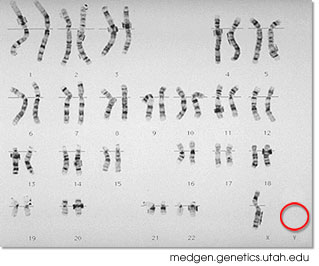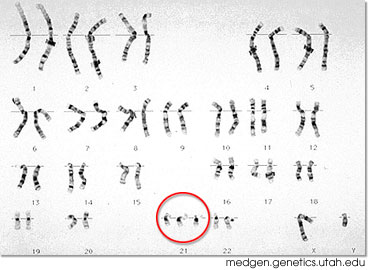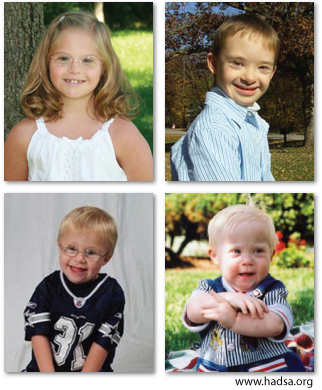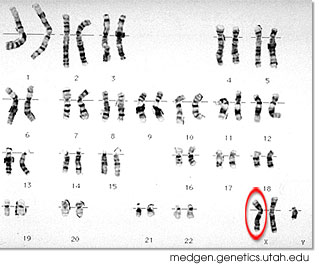Only a few types of aneuploidy are compatible with life. Trisomy 21 (a cause of Down Syndrome) is relatively common, as are conditions involving extra or missing sex chromosomes.
Genetic disorders resulting from monoploidy include:
45, XO (Turner Syndrome)
What is Turner Syndrome?
Turner syndrome is caused by having a missing or incomplete X chromosome. It affects only females.
About 20 percent of the time, both X chromosomes are present, but one is incomplete. It may be ring-shaped, or it may be missing a piece because of a chromosomal rearrangement. About 30 percent of girls with the disorder are missing the X chromosome in just some of their cells. This mixed chromosome pattern is known as mosaicism. Girls with these forms of Turner syndrome may have fewer or milder characteristics.

This karyotype shows all of the chromosomes from a person with Turner syndrome. The circle shows where the missing X chromosome would be.
Features of Turner Syndrome?

How is Turner Syndrome Managed?
Turner syndrome is best managed when a diagnosis is made as early as possible, though many girls are not diagnosed until later childhood or early adolescence. An early diagnosis makes it easier to find and monitor medical issues that are associated with the condition.
Most girls with Turner syndrome receive hormone replacement therapy. Growth hormone can help children and teens grow taller, so they can reach a height that is closer to average. Low doses of androgens (male hormones that females make a little of) can also increase height and encourage hair and muscle growth. The female hormone estrogen helps to promote sexual development.
Interesting Facts About Turner Syndrome
Genetic disorders resulting from polyploidy include:
Trisomy 21 (Down Syndrome)
What is Down Syndrome?

This karyotype shows all of the chromosomes from a person with Down syndrome. The three copies of chromosome 21 are circled.
Features of Down Syndrome?

Children with Down Syndrome
People with Down syndrome tend to have distinct facial features. They have some level of intellectual disability, which is usually mild to moderate. Children with Down syndrome usually develop more slowly than their peers. They can take longer to learn to walk, talk, and care for themselves.
People with Down syndrome are at an increased risk of having certain medical issues. These including respiratory infections, problems with the gastrointestinal (digestive) tract, leukemia (a blood cancer), eye problems, hearing loss, and hypothyroidism. Many babies are born with heart conditions, and heart problems can also appear later in life. Because of these issues, people with Down syndrome have a life expectancy that is shorter than average—about 60 years.
How is Down Syndrome Managed?
Interesting Facts About Down Syndrome
Down syndrome is really the only trisomy compatible with life. Only two other trisomies have been observed in babies born alive (trisomies 13 and 18), but babies born with these trisomies have only a 5% chance of surviving longer than one year.
In 90% of Trisomy 21 cases, the additional chromosome comes from the mother's egg rather than the father's sperm.
Down syndrome is the most common genetic disorder caused by a chromosomal abnormality. It affects 1 out of every 800 to 1,000 babies.
Down syndrome was originally described in 1866 by John Langdon Down. It wasn't until 1959 that French doctor Jerome Lejeune discovered it was caused by the inheritance of an extra chromosome 21.
47, XXY (Klinefelter Syndrome)
What is 47, XXY (Klinefelter Syndrome)?
47, XXY (or XXY) is a genetic condition caused when someone has two X chromosomes and one Y chromosome. Most males have an X chromosome and a Y chromosome (46, XY), and most females have two X chromosomes (46, XX).
Because people with an XXY chromosome arrangement have a Y chromosome, most develop as males. Often, they do not know that they have an extra chromosome. Some will develop the varied and often subtle features of Klinefelter syndrome. And a small proportion will develop as intersex (between male and female) or female. Physical features may appear around the time of puberty, when gender identity and sexual characteristics begin to form.
Similar conditions are caused by additional X chromosomes (48, XXXY; 49, XXXXY), but they are much more rare. The more X chromosomes a person has, the stronger the physical features and health problems tend to be, including intellectual disability.

This karyotype shows all of the chromosomes from a person with the 47, XXY chromosomal arrangement. The extra X chromosome is circled.
Features of 47, XXY (Klinefelter syndrome)
The XXY chromosome arrangement affects primarily sexual development. Typically, testes don't fully develop, and the levels of the hormone testosterone (important for male sexual development) are lower than average. As adults, nearly all XXY males are unable to make sperm and so cannot have biological children. Many men discover their condition only after they seek medical help for infertility.
The features of XXY (Klinefelter syndrome) can be very subtle and are highly varied. Children and adults may be taller than average, with proportionally longer arms and legs, and they may have less-muscular bodies, more belly fat, wider hips, narrower shoulders, or minor to moderate learning disabilities. Changes that appear at puberty can include low growth of facial and body hair, development of breast tissue, and small testes.
XXY individuals are also more likely to develop certain medical conditions, including osteoporosis (weak bones), varicose veins, type 2 diabetes, and heart valve defects. As adults, they are just as likely as XX females to develop breast cancer and certain autoimmune disorders.

How is 47, XXY (Klinefelter Syndrome) Managed?
Knowing an individual's chromosomal status is important for both their physical and emotional health. Early diagnosis can alert doctors to the need for bone-density and hormone-level monitoring. Educators can be on the lookout for learning disabilities. XXY individuals also may need emotional support and counseling, especially during puberty. Boys who develop breast tissue or who do not develop facial or body hair may feel self-conscious. Teens may need support as they face gender identity issues.
Teens and adults who wish to be treated can be given hormones. The hormone testosterone will help them develop more typically male characteristics, and estrogen will help them develop more typically female characteristics. Those who choose can have surgery to remove breast tissue.
Many 47, XXY individuals are quite typical males who receive no treatment. Those who wish to have children can often be helped with reproductive technologies.